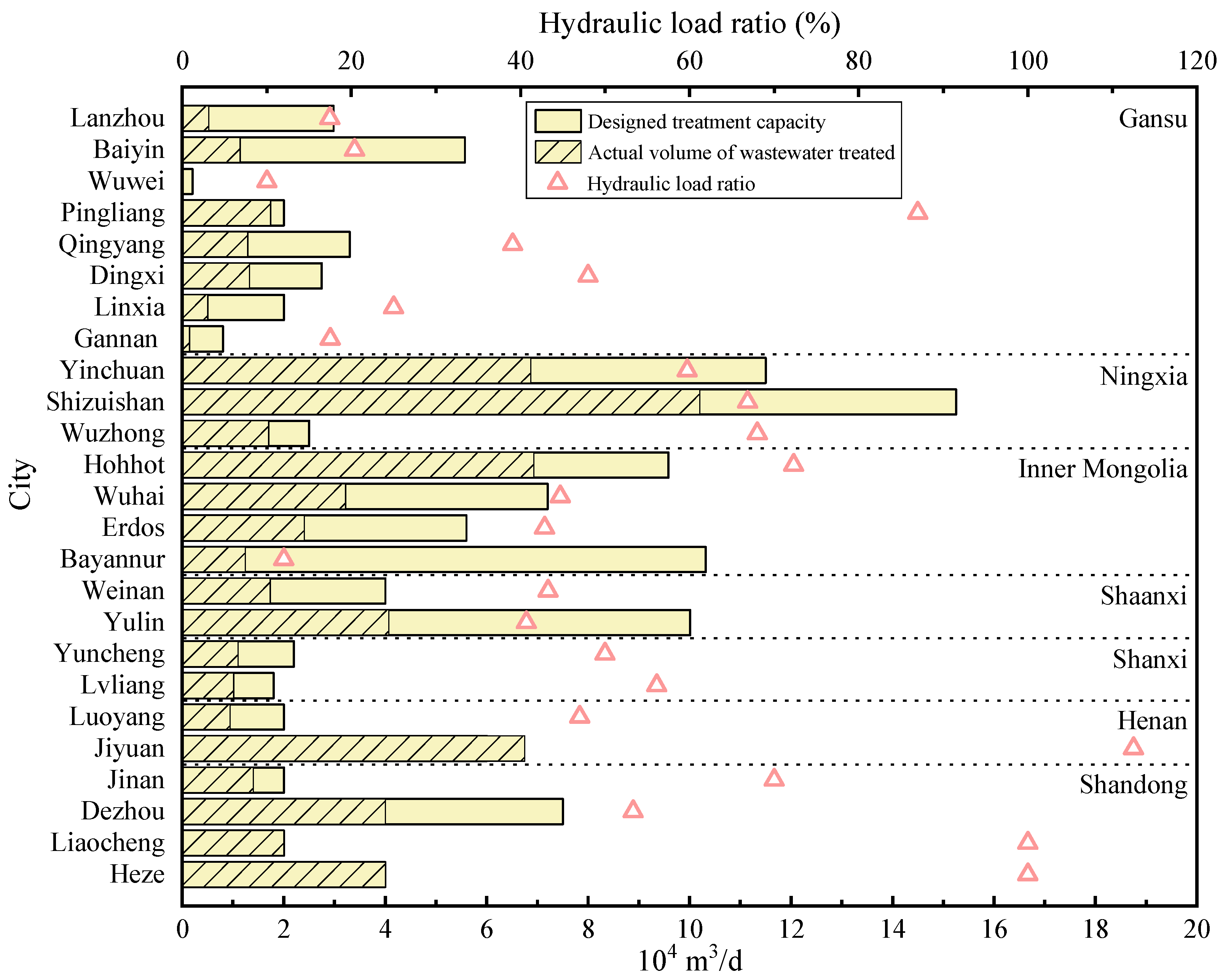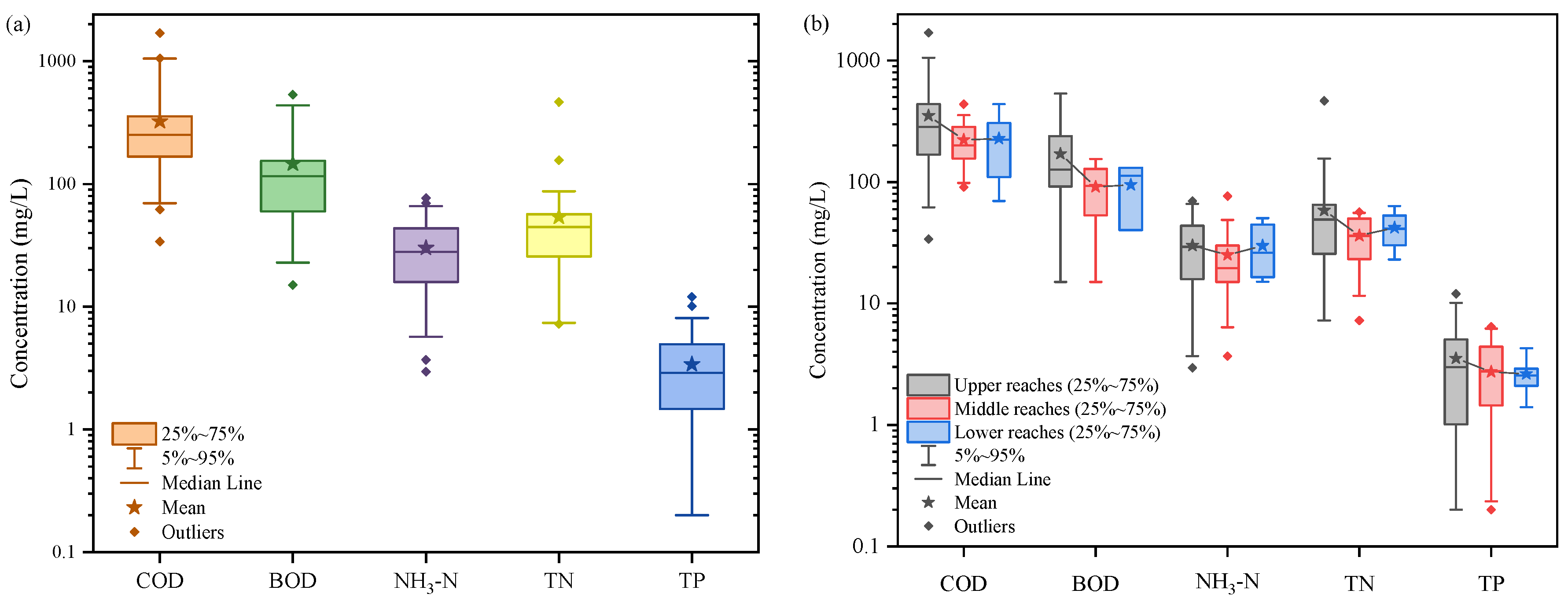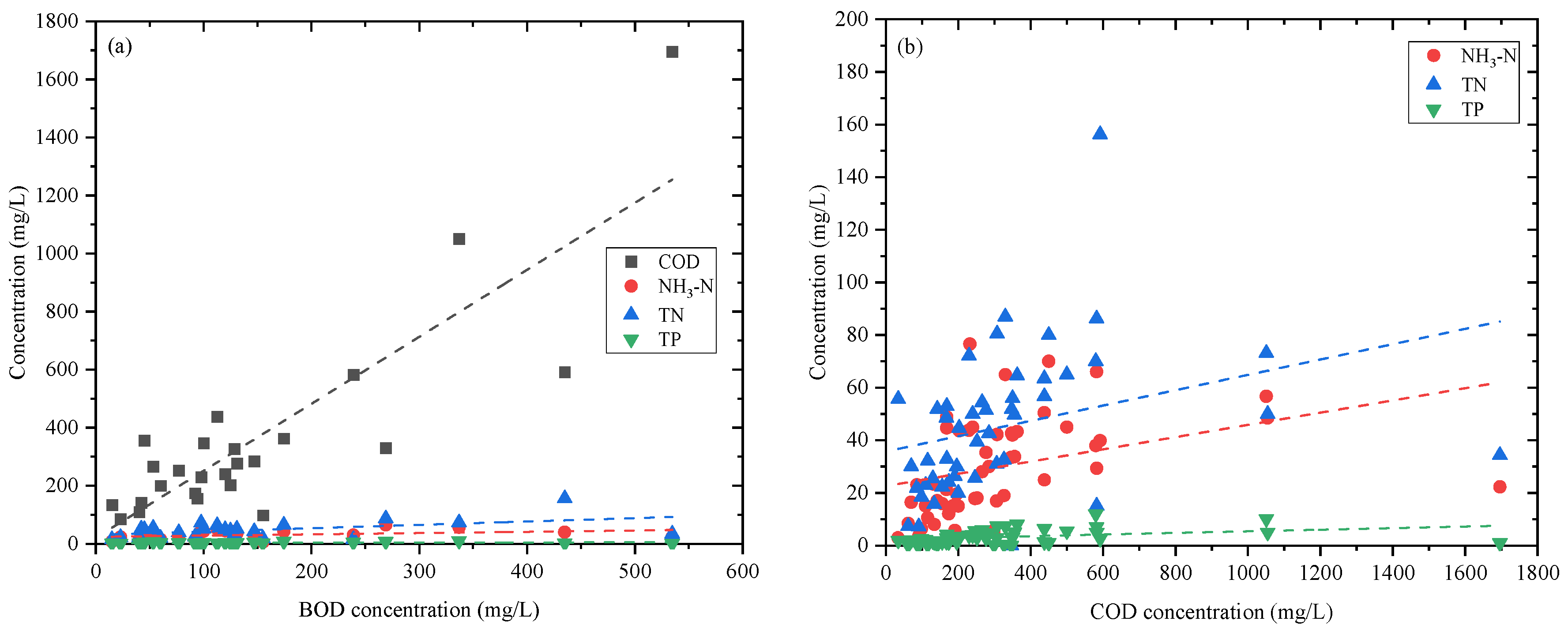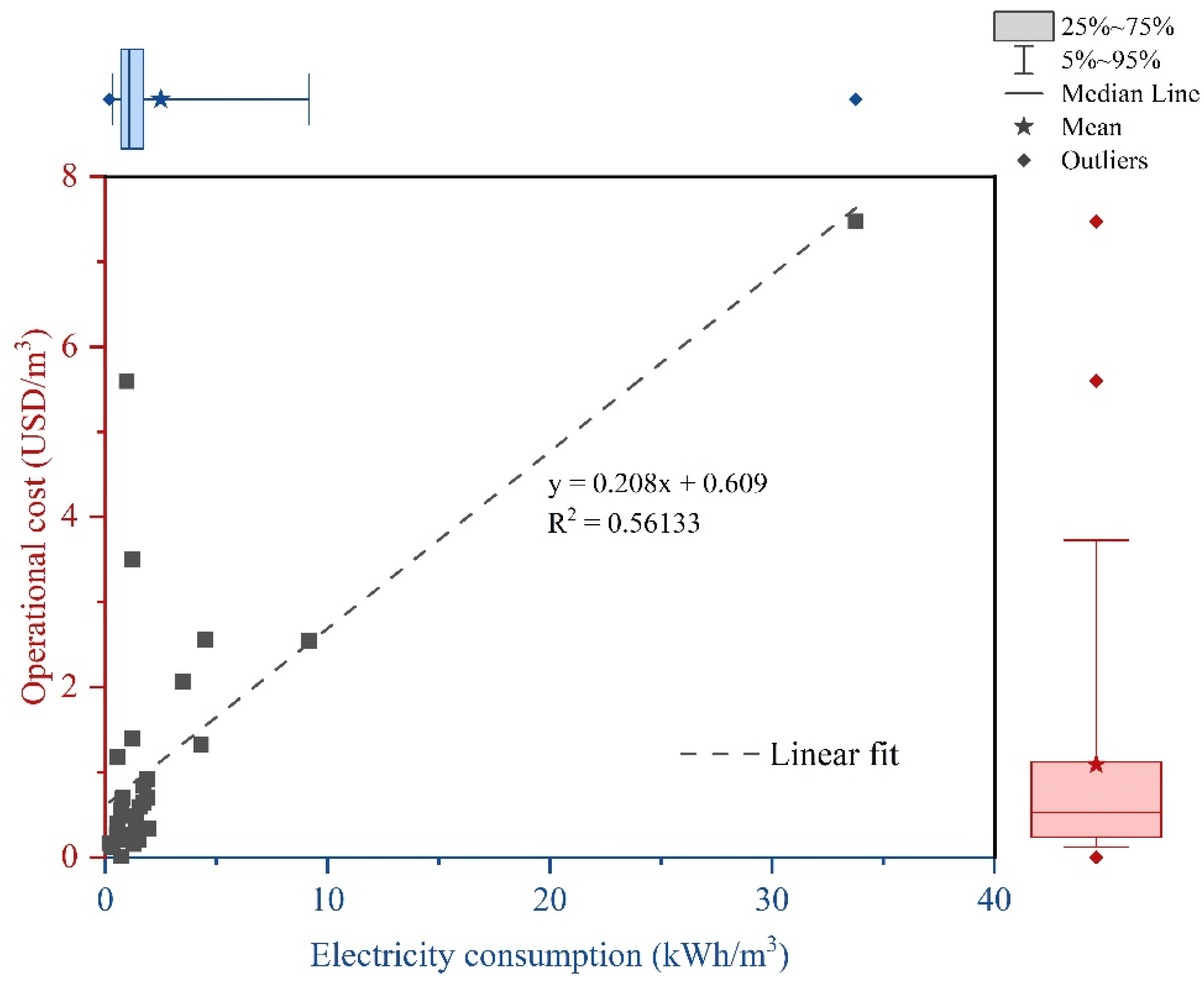Analysis on Operation and Water Quality Characteristics of Centralized Wastewater Treatment Plants of Industrial Parks in Yellow River Basin, China
Abstract
:1. Introduction
2. Methods
2.1. Data Collection
2.2. Data Analysis
3. Results and Discussion
3.1. Operating Status
3.1.1. Treatment Capacity of Centralized Industrial WWTPs
3.1.2. Wastewater Treatment Process
3.2. Characteristics of Influent Quality
3.2.1. Influent Quality of Industrial, Centralized WWTPs
3.2.2. Ratios of Water Quality Parameters
3.2.3. Correlation of Influent Water Quality Parameters
3.3. Energy Consumption and Operational Cost
4. Conclusions
Author Contributions
Funding
Data Availability Statement
Conflicts of Interest
References
- Eliasson, J. The rising pressure of global water shortages. Nature 2015, 517, 6. [Google Scholar] [CrossRef]
- Zhang, Q.; Xu, C.Y.; Yang, T. Variability of water resource in the Yellow River basin of past 50 years, China. Water Resour. Manag. 2009, 23, 1157–1170. [Google Scholar] [CrossRef]
- Chen, Y.; Fu, B.; Zhao, Y.; Wang, K.; Zhao, M.M.; Ma, J.; Wu, J.; Xu, C.; Liu, W.; Wang, H. Sustainable development in the Yellow River Basin: Issues and strategies. J. Clean. Prod. 2020, 263, 121223. [Google Scholar] [CrossRef]
- Liu, J.; Zang, C.; Tian, S.; Liu, J.; Yang, H.; Jia, S.; You, L.; Liu, B.; Zhang, M. Water conservancy projects in China: Achievements, challenges and way forward. Glob. Environ. Chang. 2013, 23, 633–643. [Google Scholar] [CrossRef]
- Central Committee of the Communist Party of China and the State Council. Outline of Ecological Protection and High-Quality Development Plan for the Yellow River Basin (China State Council Publication No. ADM 30-1749). Available online: https://www.gov.cn/gongbao/content/2021/content_5647346.htm (accessed on 20 February 2024).
- Lu, D.; Sun, D. Development and management tasks of the Yellow River Basin: A preliminary understanding and suggestion. Acta Geogr. Sin. 2019, 74, 2431–2436. [Google Scholar]
- Hu, J.; Liu, Y.; Fang, J.; Jing, Y.; Liu, Y.; Liu, Y. Characterizing pollution-intensive industry transfers in China from 2007 to 2016 using land use data. J. Clean. Prod. 2019, 223, 424–435. [Google Scholar] [CrossRef]
- Yang, X.; Feng, Z.; Chen, Y. Evaluation and obstacle analysis of high-quality development in Yellow River Basin and Yangtze River Economic Belt, China. Humanit. Soc. Sci. Commun. 2023, 10, 757. [Google Scholar] [CrossRef]
- Chen, Y.; Zhu, M.; Lu, J.; Zhou, Q.; Ma, W. Evaluation of ecological city and analysis of obstacle factors under the background of high-quality development: Taking cities in the Yellow River Basin as examples. Ecol. Indic. 2020, 118, 106771. [Google Scholar] [CrossRef]
- Feng, Z.; Chen, Y.; Yang, X. Measurement of Spatio-Temporal Differences and Analysis of the Obstacles to High-Quality Development in the Yellow River Basin, China. Sustainability 2022, 14, 14179. [Google Scholar] [CrossRef]
- Wang, H.; Ma, T. Optimal water resource allocation considering virtual water trade in the Yellow River Basin. Sci. Rep. 2024, 14, 79. [Google Scholar] [CrossRef]
- Engelman, R.; LeRoy, P. Sustaining Water: Population and Future of Renewable Water Supplies; Population Action International: Washington, DC, USA, 1993; Volume 23, p. 296. [Google Scholar]
- Ministry of Water Resources of the People’s Republic of China. China Water Resource Bulletin. 2020. Available online: http://dsgl.mwr.gov.cn/dszs/202212/P020221228567515805249.pdf (accessed on 20 February 2024).
- Sun, J.; Wang, X.; Shahid, S.; Yin, Y.; Li, E. Spatiotemporal changes in water consumption structure of the Yellow River Basin, China. Phys. Chem. Earth 2022, 126, 103112. [Google Scholar] [CrossRef]
- Ministry of Ecology and Environment of the People’s Republic of China. China Ecological Environment Status Bulletin. 2022. Available online: https://www.mee.gov.cn/hjzl/sthjzk/zghjzkgb/202305/P020230529570623593284.pdf (accessed on 20 February 2024).
- Sakr, D.; Baas, L.; El-Haggar, S.; Huisingh, D. Critical success and limiting factors for eco-industrial parks: Global trends and Egyptian context. J. Clean. Prod. 2011, 19, 1158–1169. [Google Scholar] [CrossRef]
- National Development and Reform Commission, China. Audit Notice Catalogue of Chinese Development Zones. 2018. Available online: https://www.ndrc.gov.cn/fggz/lywzjw/zcfg/201803/t20180302_1047056.html (accessed on 20 February 2024).
- Chertow, M.R. Industrial symbiosis: Literature and taxonomy. Annu. Rev. Energy Environ. 2000, 25, 313–337. [Google Scholar] [CrossRef]
- Tian, J.; Liu, W.; Lai, B.; Li, X.; Chen, L. Study of the performance of eco-industrial park development in China. J. Clean. Prod. 2014, 64, 486–494. [Google Scholar] [CrossRef]
- Liu, J.; Liu, T.; Su, Y.; Wang, J.; Chen, M. Analysis on operation and water quality characteristics of industrial wastewater treatment plants in China. Water Wastewater Eng. 2021, 47, 92–96, 103. [Google Scholar]
- Kuok, K.K.; Chiu, P.C.; Rahman, M.R.; Bakri, M.K.B.; Chin, M.Y. Effectiveness of centralized wastewater treatment plant in removing emerging contaminants: A case study at Kuching, Malaysia. J. Water Resour. Prot. 2022, 14, 650–663. [Google Scholar] [CrossRef]
- Wang, H.; Qi, T.; Qiao, X.; Li, X.; Ding, S.; Liu, Y. Method for ensuring the safety and effectiveness of wastewater treatment under centralized treatment mode by using a petrochemical park as case study. J. Water Process Eng. 2023, 56, 104421. [Google Scholar] [CrossRef]
- Liu, H.; Wang, H.; Zhou, X.; Fan, J.; Liu, Y.; Yang, Y. A comprehensive index for evaluating and enhancing effective wastewater treatment in two industrial parks in China. J. Clean. Prod. 2019, 230, 854–861. [Google Scholar] [CrossRef]
- Zhao, W.; Wang, M.; Li, J.; Huang, Y.; Li, B.; Pan, C.; Li, X.; Peng, Y. Optimization of denitrifying phosphorus removal in a predenitrification anaerobic/anoxic/post-aeration + nitrification sequence batch reactor (pre-A2NSBR) system: Nitrate recycling, carbon/nitrogen ratio and carbon source type. Front. Environ. Sci. Eng. 2018, 12, 8. [Google Scholar] [CrossRef]
- Zhang, B.; Ning, D.; Yang, Y.; Van Nostrand, J.D.; Zhou, J.; Wen, X. Biodegradability of wastewater determines microbial assembly mechanisms in full-scale wastewater treatment plants. Water Res. 2020, 169, 115276. [Google Scholar] [CrossRef]
- Zhou, J.; Wang, Y.N.; Zhang, W.; Shi, B. Nutrient balance in aerobic biological treatment of tannery wastewater. J. Am. Leather Chem. Assoc. 2014, 109, 154–160. [Google Scholar]
- Ding, S.Z.; Bao, P.; Bo, W.; Zhang, Q.; Peng, Y.Z. Long-term stable simultaneous partial nitrification, anammox and denitrification (SNAD) process treating real domestic sewage using suspended activated sludge. Chem. Eng. J. 2018, 339, 180–188. [Google Scholar] [CrossRef]
- Zou, L.; Li, H.; Wang, S.; Zheng, K.; Wang, Y.; Du, G.; Li, J. Characteristic and correlation analysis of influent and energy consumption of wastewater treatment plants in Taihu Basin. Front. Environ. Sci. Eng. 2019, 13, 83. [Google Scholar] [CrossRef]
- Yan, P.; Shi, H.X.; Chen, Y.P.; Gao, X.; Fang, F.; Guo, J.S. Optimization of recovery and utilization pathway of chemical energy from wastewater pollutants by a net-zero energy wastewater treatment model. Renew. Sustain. Energy Rev. 2020, 133, 110160. [Google Scholar] [CrossRef]
- Xu, A.; Wu, Y.; Chen, Z.; Hao, S.; Hu, H. Analysis of the current situation of construction and operation of municipal wastewater treatment plants in the Yellow River basin. Water Wastewater Eng. 2022, 48, 27–36. [Google Scholar]







| Water Treatment Capacity (104 m3/d) | Number | ||||||
|---|---|---|---|---|---|---|---|
| Gansu | Ningxia | Inner Mongolia | Shaanxi | Shanxi | Henan | Shandong | |
| <0.5 | 6 | 0 | 4 | 0 | 2 | 0 | 0 |
| 0.5~1 | 2 | 1 | 0 | 0 | 1 | 0 | 0 |
| 1~5 | 9 | 12 | 6 | 5 | 2 | 4 | 5 |
| 5~10 | 0 | 1 | 1 | 1 | 0 | 0 | 0 |
| ≥10 | 0 | 0 | 1 | 0 | 0 | 0 | 0 |
| Index | COD | NH3-N | TN | TP |
|---|---|---|---|---|
| BOD | Y = 2.3079x + 20.544 R2 = 0.73118 | y = 0.0435x + 24.028 R2 = 0.12457 | y = 0.11587x + 30.322 R2 = 0.24157 | y = 0.00472x + 2.7249 R2 = 0.05991 |
| COD | y = 0.02323x + 22.626 R2 = 0.1309 | y = 0.02913x + 35.744 R2 = 0.10026 | y = 0.00306x + 2.3627 R2 = 0.11159 | |
| NH3-N | y = 1.0262x + 14.548 R2 = 0.426 | y = 0.07964x + 1.0196 R2 = 0.26939 | ||
| TN | y = 0.04608x + 1.3470 R2 = 0.22071 |
Disclaimer/Publisher’s Note: The statements, opinions and data contained in all publications are solely those of the individual author(s) and contributor(s) and not of MDPI and/or the editor(s). MDPI and/or the editor(s) disclaim responsibility for any injury to people or property resulting from any ideas, methods, instructions or products referred to in the content. |
© 2024 by the authors. Licensee MDPI, Basel, Switzerland. This article is an open access article distributed under the terms and conditions of the Creative Commons Attribution (CC BY) license (https://creativecommons.org/licenses/by/4.0/).
Share and Cite
Wang, Y.; Yuan, Y.; Xue, H.; Yu, Y.; Shi, Y.; Wen, H.; Xu, M. Analysis on Operation and Water Quality Characteristics of Centralized Wastewater Treatment Plants of Industrial Parks in Yellow River Basin, China. Water 2024, 16, 806. https://doi.org/10.3390/w16060806
Wang Y, Yuan Y, Xue H, Yu Y, Shi Y, Wen H, Xu M. Analysis on Operation and Water Quality Characteristics of Centralized Wastewater Treatment Plants of Industrial Parks in Yellow River Basin, China. Water. 2024; 16(6):806. https://doi.org/10.3390/w16060806
Chicago/Turabian StyleWang, Yanjun, Yue Yuan, Hao Xue, Yin Yu, Yang Shi, Huina Wen, and Min Xu. 2024. "Analysis on Operation and Water Quality Characteristics of Centralized Wastewater Treatment Plants of Industrial Parks in Yellow River Basin, China" Water 16, no. 6: 806. https://doi.org/10.3390/w16060806





